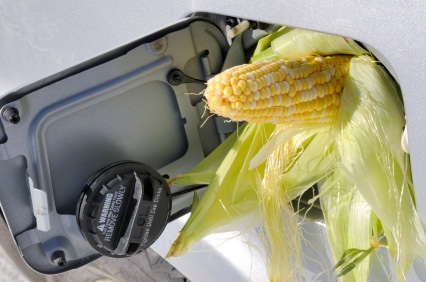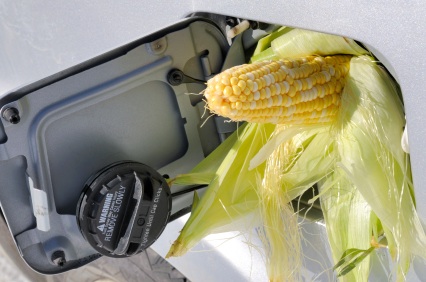 It’s food, no fuel, no food…For the ethanol industry, much depends on distillers grains, the stuff that’s left over after corn has been fermeneted and distilled to make alcohol. Corn ethanol’s energy balance (net energy produced minus energy consumed in production) is razor thin; it only goes positive when you factor in generous credits for distillers grains. Then there’s the harsh economic reality: With corn prices stubbornly high and ethanol prices stubbornly low, not even $5 billion or so a year in government support can keep the industry from bleeding red ink. The industry has been scraping by on revenue generated by selling distillers grains as a livestock feed — and issuing glowing reports about the wonders of ethanol waste in cow, poultry, and hog rations.
It’s food, no fuel, no food…For the ethanol industry, much depends on distillers grains, the stuff that’s left over after corn has been fermeneted and distilled to make alcohol. Corn ethanol’s energy balance (net energy produced minus energy consumed in production) is razor thin; it only goes positive when you factor in generous credits for distillers grains. Then there’s the harsh economic reality: With corn prices stubbornly high and ethanol prices stubbornly low, not even $5 billion or so a year in government support can keep the industry from bleeding red ink. The industry has been scraping by on revenue generated by selling distillers grains as a livestock feed — and issuing glowing reports about the wonders of ethanol waste in cow, poultry, and hog rations.
About a month ago, AP reported that the FDA is taking a hard look at just how wonderful distillers grains are, after all. (I posted about it here; and recently found an extended take on the FDA’s distillers grains investigations from a National Feed and Grain Association newsletter (PDF) from way back in January). You see, ethanol production is an industrial process whose main product is meant to be burned in car engines. So its “byproducts” are essentially industrial waste, containing all manner of residues not meant to be consumed by living beings. The AP report says that the FDA has found antibiotic residues in distillers grains significantly higher than allowable thresholds. (For two antibiotic residues the agency found in distillers grains, no “safe” levels have even been established). There’s nothing surprising about the issue; as I reported last year, the Canadian government has been fretting about industrial residues in ethanol waste destined for livestock feed for a while.
So imagine my bemusement when I came across this, from the Des Moines Register:
Food and beverage manufacturers are looking at distiller’s grains for ingredients such as phytosterols, lecithin and carotenoid antioxidants to make products healthier, consultant John Boyd Jr. said.
Come again? The FDA is worried that ethanol waste carries too many residues to be fit for livestock feed, and now the food industry is blithely considering diverting it into people food? Yes, evidently the food marketers want to tart p distillers grains and peddle them as “functional foods.” Indeed, a consulatancy called Boyd Company recently conducted a study to identify the best locales for establishing a “functional foods” factory, and geographic “proximity to ethanol production and access to byproducts of this process” played a large role in their ranking, according to the Website NutraIngredients-USA.com. NutraIngredients continues:
“The massive increase in ethanol production in the US has also resulted in a similar increase in its most valuable residual product: DDG (distiller’s dried grain),” writes Boyd.
“Phytosterols, lecithin, as well as carotenoid antioxidants, such as lycopene, are some of the ingredients that are being researched and expected to be mass produced from DDG for the functional foods and nutritional beverage industry.”
Sounds yummy — just the thing to spice up a “meal-replacement” bar! As a result of this fixation on distillers grains, the cities that Boyd ranked most attractive for launching a “functional food” factoey tended to be in the Midwest. Here’s the top five: 1)Sioux Falls, South Dakota; 2) Saskatoon, Saskatchewan; 3) Salt Lake City/Provo; 4) Winnipeg, Manitoba; and 5) Des Moines, Iowa.




